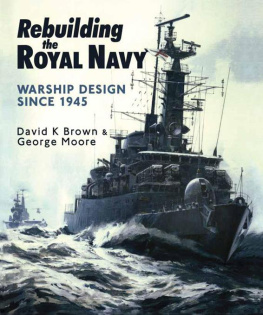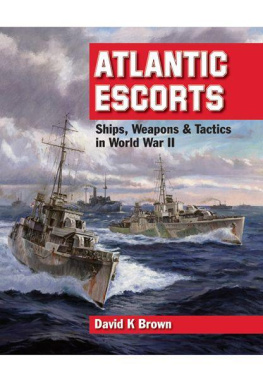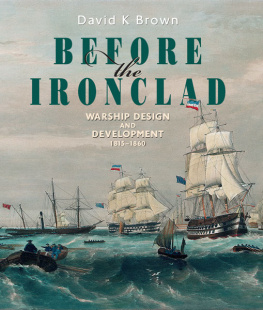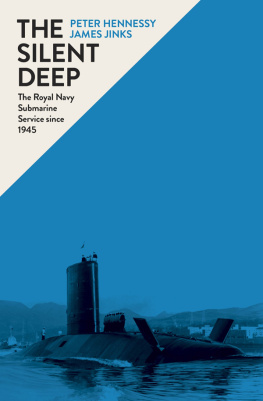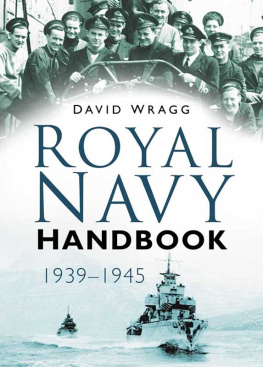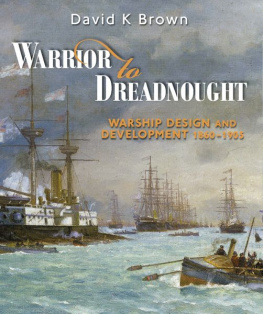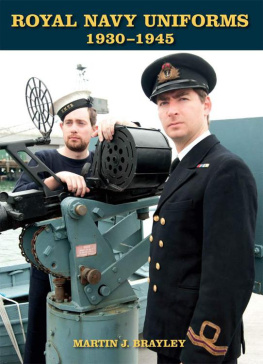D. K. Brown - Rebuilding the Royal Navy Warship Design Since 1945
Here you can read online D. K. Brown - Rebuilding the Royal Navy Warship Design Since 1945 full text of the book (entire story) in english for free. Download pdf and epub, get meaning, cover and reviews about this ebook. year: 2012, publisher: Seaforth Publishing Pen and Sword, genre: Romance novel. Description of the work, (preface) as well as reviews are available. Best literature library LitArk.com created for fans of good reading and offers a wide selection of genres:
Romance novel
Science fiction
Adventure
Detective
Science
History
Home and family
Prose
Art
Politics
Computer
Non-fiction
Religion
Business
Children
Humor
Choose a favorite category and find really read worthwhile books. Enjoy immersion in the world of imagination, feel the emotions of the characters or learn something new for yourself, make an fascinating discovery.
- Book:Rebuilding the Royal Navy Warship Design Since 1945
- Author:
- Publisher:Seaforth Publishing Pen and Sword
- Genre:
- Year:2012
- Rating:3 / 5
- Favourites:Add to favourites
- Your mark:
- 60
- 1
- 2
- 3
- 4
- 5
Rebuilding the Royal Navy Warship Design Since 1945: summary, description and annotation
We offer to read an annotation, description, summary or preface (depends on what the author of the book "Rebuilding the Royal Navy Warship Design Since 1945" wrote himself). If you haven't found the necessary information about the book — write in the comments, we will try to find it.
D. K. Brown: author's other books
Who wrote Rebuilding the Royal Navy Warship Design Since 1945? Find out the surname, the name of the author of the book and a list of all author's works by series.
Rebuilding the Royal Navy Warship Design Since 1945 — read online for free the complete book (whole text) full work
Below is the text of the book, divided by pages. System saving the place of the last page read, allows you to conveniently read the book "Rebuilding the Royal Navy Warship Design Since 1945" online for free, without having to search again every time where you left off. Put a bookmark, and you can go to the page where you finished reading at any time.
Font size:
Interval:
Bookmark:
Rebuilding
the
ROYAL NAVY

Rebuilding
the
ROYAL NAVY
WARSHIP DESIGN SINCE 1945
D K BROWN RCNC & GEORGE MOORE
Line Drawings by JOHN ROBERTS
Seaforth
P U B L I S H I N G
Frontispiece
The Batch III Type 42 destroyer Manchester in heavy seas off Australia. Since 1945
British warships have established an enviable reputation for their seakeeping. (MoD)
Copyright David K Brown & George Moore 2003
This edition first published in Great Britain in 2012 by
Seaforth Publishing,
Pen & Sword Books Ltd,
47 Church Street,
Barnsley S70 2AS
First published by Chatham Publishing 2003
Reprinted 2012
www.seaforthpublishing.com
British Library Cataloguing in Publication Data
A catalogue record for this book is available from the British Library
ISBN 978 184832 150 2
All rights reserved. No part of this publication may be reproduced or transmitted in
any form or by any means, electronic or mechanical, including photocopying,
recording, or any information storage and retrieval system, without prior permission
in writing of both the copyright owner and the above publisher.
The right of David K Brown & George Moore to be identified as the authors of this
work has been asserted by them in accordance with the Copyright, Designs and
Patents Act 1988.
Typeset and designed by Roger Daniels
Printed and bound in China by 1010 International, Limited
Contents
D K Brown
In some ways, this is the sequel to my series of four books dealing with British warship design from 1800 to the end of the Second World War. It is similar in that it concentrates on naval architecture and marine engineering, with developments in weapons, electronics etc, mentioned only in so far as they affect the design of the ship. For much of the period, this distinction governed design, enshrined in the separation of DG Ships and DG Weapons.
However, this book differs from its predecessors in several important aspects. The Thirty Year Rule means that official documents are not available for the whole period, though much information is given at an earlier stage than in the past. Nor can I pretend to be unbiased, as I was party to many of the decisions made. On the other hand, I can give an insiders view which some later historian may use in less biased form. This is my excuse for intruding my memories into George Moores chapters! Rather than attempting to impose a uniform style, we have chosen a lead author for each chapter (George Moore for , and David Brown for the remainder); but each chapter has been vetted by both authors, who may have inserted their views.
This was a period of great change: in particular, the RN was no longer the biggest and, in some aspects, not even the best navy in the world, but it was a long time before the government, the Navy itself and the general public realised and accepted this fact. Technically, armour and (except in nuclear submarines) steam engines disappeared, and guns lost their predominance. Electronics dominated the topside layout and had a major impact inside. Everyone expected vastly better living conditions. At the same time, many ship classes were severely cost-limited.
Nuclear weapons influenced building policy as well as the design of ships, while submarines turned to nuclear power (it was also considered for surface ships). Considerable space has been devoted to designs that were not built, as often these form the missing link between classes that were put into service, and they are inherently fascinating as so little is known about them.
And now a word from my co-author.
George Moore
The reader may wonder just why a second author is involved in the compilation of this work. The answer lies in the expanse of time and the sheer complexity of the subject in an period lasting more than 50 years.
The chapters for which I take prime responsibility are set in the first two decades covered by the book. The evolution of each warship design is chronicled by the use of original documents to ensure that the history is accurate. However, as a general rule only some 1 per cent of the paper produced by government departments survives in archives, which inevitably means that there are gaps in the detail. Another problem faced is that some records are restricted for far longer than the stipulated 30 years for either security or practical reasons. Some warships do, after all, have very long lives, and policies, particularly in the nuclear area, have sensitive security considerations. It is, however, feasible to compile an outline history of each class from conception to birth, and this has been this authors aim. The political and financial aspects are not neglected.
The first two decades of the post-war era, although not encompassing major hostilities, were some of the most dramatic, technically and economically, in the long history of the Royal Navy. The battleship died, the cruiser and destroyer were effectively merging, the desirable aircraft carrier proved unaffordable, whilst the submarine grew into one of the worlds most formidable weapons. It is a fascinating story.
Any views expressed are those of the authors and do not necessarily represent those of the Ministry of Defence.
Acknowledgements
As usual, this book would not be possible without the help of many friends.
First come former colleagues who contributed so much to the design of the ships described in this book and then put their memories on paper: Messrs Alan Bull, Martin Cawte, (Dr) David Chalmers, (Dr) John Coates, Alan Creighton, Keith Foulger, Geoff Fuller, Norman Gundry, Arthur Honnor, Jim Lawrence, Peter Lover, Dennis ONeill, Doug Pattison, Ken Purvis, Jack Revans, Eric Tupper, (Dr) Peter Usher, Alfred Vosper, Brian Wall, Fred Yearling, all RCNC, also Miss Mcnair, the HTP specialist, and Les Savage. Also Nick Pattison and John Sadden, shipbuilders, and Ian Johnston.
Then the keepers of historical records and librarians: John Shears (Journal of Naval Engineering); Ms Jenny Wraight (Admiralty Librarian); the late J David Brown and his successor at Naval Historical Branch, Chris Page; Bob Todd and his staff (National Maritime Museum, Brass Foundry); the Cambridge University Library (Vickers Archive); the Public Record Office; the Chairman of the World Ship Society, Dr Richard Osborne.
The Chief Executive, Royal Institution of Naval Architects is thanked for permission to quote from RINA papers. The Crown Copyright Administrator is also thanked. Some illustrations are Crown Copyright MoD, reproduced with the permission of Her Majestys Stationary Office and individually identified as MoD.
We are particularly grateful to John Roberts, who has not only drawn many illustrations but has also cast an informed and critical eye over the text. Other drawings are by Len Crockford. BAE SYSTEMS, the World Ship Society, Walter Cloots and Mike Lennon are thanked for permission to use their photographs.
The political and economic background to the Royal Navy over half a century is far too complicated to cover in part of a chapter, let alone when linked to the events of the Cold War. However, many key events greatly affected the size and shape of the Navy and a brief note seems necessary. In 1945 the RN was the second biggest navy in the world with the navy in third place a very long way behind. On the other hand, most of its ships were of pre-war design, obsolescent and worn out from years of wartime steaming.
Font size:
Interval:
Bookmark:
Similar books «Rebuilding the Royal Navy Warship Design Since 1945»
Look at similar books to Rebuilding the Royal Navy Warship Design Since 1945. We have selected literature similar in name and meaning in the hope of providing readers with more options to find new, interesting, not yet read works.
Discussion, reviews of the book Rebuilding the Royal Navy Warship Design Since 1945 and just readers' own opinions. Leave your comments, write what you think about the work, its meaning or the main characters. Specify what exactly you liked and what you didn't like, and why you think so.

